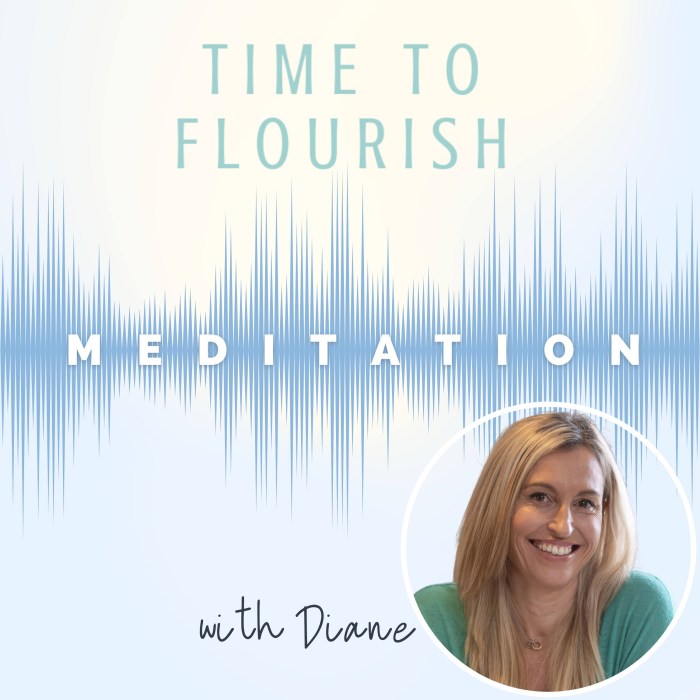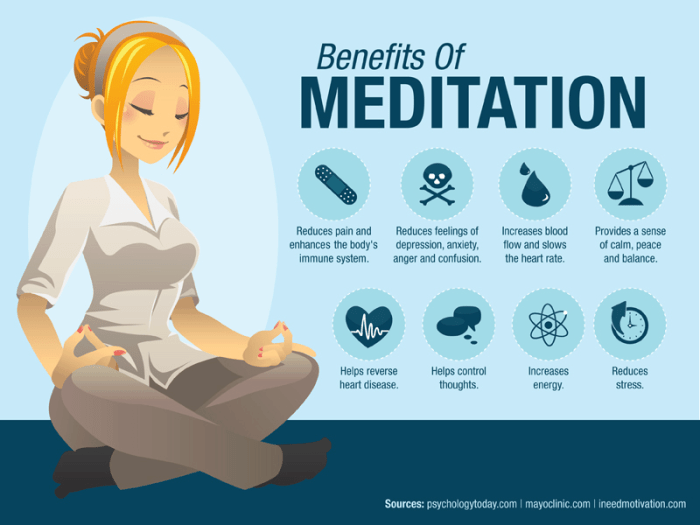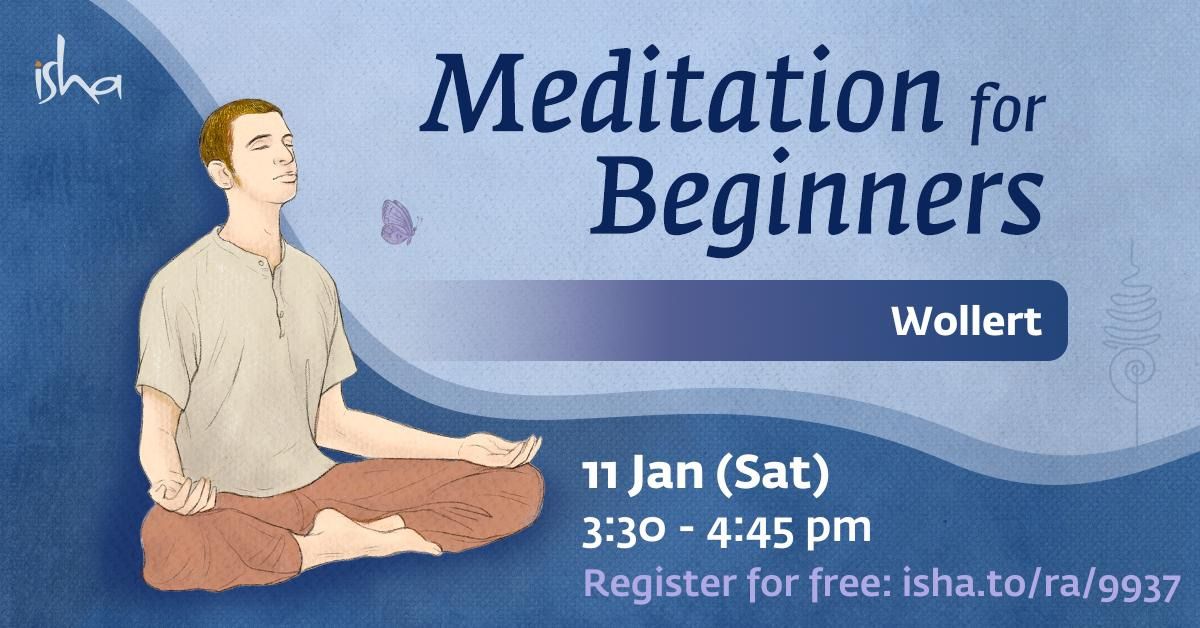Exploring 20 Easy Meditation Practices for Beginners, this introduction invites readers into a world of tranquility and self-discovery. From mindfulness techniques to breathing exercises, embark on a journey towards a calmer mind and healthier well-being.
Discover the essence of each practice and how they can transform your daily life, providing a gateway to mindfulness and inner harmony.
Introduction to Meditation

Meditation is a powerful practice that offers numerous benefits for beginners and experienced practitioners alike. It involves focusing the mind and eliminating distractions, leading to a state of inner peace and clarity. For beginners, meditation can be a valuable tool for reducing stress, improving mental well-being, and enhancing overall quality of life.
Benefits of Meditation Practices
- Stress Reduction: Meditation helps calm the mind and body, reducing stress levels and promoting relaxation.
- Improved Focus: By training the mind to concentrate on the present moment, meditation can enhance focus and attention span.
- Emotional Well-being: Regular meditation can help regulate emotions, leading to increased feelings of positivity and happiness.
- Enhanced Self-awareness: Through introspection and self-reflection, meditation allows individuals to gain a deeper understanding of themselves.
- Better Sleep: Practicing meditation before bed can promote better sleep quality and help alleviate insomnia.
How Meditation Reduces Stress and Improves Mental Well-being
Meditation works by activating the body’s relaxation response, which helps lower cortisol levels and reduce the impact of stress on the body. By quieting the mind and focusing on the present moment, individuals can break free from negative thought patterns and achieve a sense of calm and inner peace. Over time, regular meditation practice can rewire the brain, leading to lasting improvements in mental well-being.
Mindfulness Meditation Techniques

Mindfulness meditation involves focusing on the present moment without judgment, allowing thoughts and feelings to come and go without getting caught up in them. This practice helps cultivate awareness, attention, and acceptance of one’s experiences.
Step-by-Step Guide for Beginners
- Find a quiet and comfortable place to sit or lie down.
- Close your eyes and bring your attention to your breath, focusing on the sensations of inhaling and exhaling.
- Notice any thoughts, feelings, or sensations that arise without trying to change them.
- If your mind starts to wander, gently bring your focus back to your breath without judgment.
- Continue this practice for 5-10 minutes, gradually increasing the duration as you become more comfortable.
Benefits of Mindfulness Meditation
- Reduces stress and anxiety by promoting relaxation and calmness.
- Improves focus, concentration, and cognitive function.
- Enhances self-awareness and emotional regulation.
- Promotes better sleep quality and overall well-being.
Breathing Exercises for Meditation: 20 Easy Meditation Practices For Beginners

Breathing exercises play a crucial role in meditation as they help in calming the mind, increasing focus, and promoting relaxation. By focusing on the breath, beginners can anchor themselves in the present moment and create a sense of inner peace.
Diaphragmatic Breathing
- Also known as belly breathing, this technique involves inhaling deeply through the nose, allowing the diaphragm to expand and the belly to rise.
- Hold the breath for a few seconds before exhaling slowly through the mouth, feeling the belly fall.
- Repeat this process for a few minutes to center yourself and release tension.
Box Breathing
- Inhale for a count of four, hold the breath for a count of four, exhale for a count of four, and then hold the breath for another count of four.
- Repeat this cycle several times, focusing on the steady rhythm of your breath and the pauses in between.
Nadi Shodhana (Alternate Nostril Breathing)
- Close your right nostril with your thumb and inhale through your left nostril.
- Close the left nostril with your ring finger, release the right nostril, and exhale through the right nostril.
- Inhale through the right nostril, close it, release the left nostril, and exhale through the left nostril. Repeat this cycle.
Proper breathing techniques can enhance the meditation experience by calming the mind, increasing oxygen flow to the brain, and reducing stress and anxiety levels. By incorporating different breathing exercises into your meditation practice, you can deepen your focus, relaxation, and overall sense of well-being.
Body Scan Meditation

Body scan meditation is a mindfulness practice that involves bringing awareness to each part of the body, systematically scanning from head to toe. The purpose of this meditation is to connect the mind and body, release tension, and cultivate a deep sense of relaxation and self-awareness.
How to Perform Body Scan Meditation, 20 Easy Meditation Practices for Beginners
To begin a body scan meditation as a beginner, find a comfortable position either sitting or lying down. Close your eyes and focus on your breath for a few moments to center yourself. Then, slowly bring your attention to different parts of your body, starting from the top of your head and moving down to your toes. As you focus on each body part, notice any sensations without judgment.
If you encounter tension or discomfort, breathe into that area and visualize the tension melting away. Take your time scanning through each body part, allowing yourself to fully relax and let go of any stress or worries.
Benefits of Body Scan Meditation
- Relaxation: Body scan meditation helps release physical tension and promote relaxation throughout the body, leading to a sense of calmness and peace.
- Self-awareness: By bringing attention to each part of the body, you become more attuned to your physical sensations, emotions, and overall well-being.
- Stress reduction: This practice can help reduce stress and anxiety by allowing you to let go of negative thoughts and emotions stored in the body.
- Improved sleep: Body scan meditation can also improve sleep quality by relaxing the body and mind before bedtime, promoting a restful night’s sleep.
Loving-Kindness Meditation

Loving-Kindness Meditation, also known as Metta Bhavana in Pali, is a practice that originated in Buddhist traditions. It involves cultivating feelings of love, compassion, and goodwill towards oneself and others. This practice helps in developing positive emotions and creating a sense of interconnectedness with all beings.
Step-by-Step Approach for Beginners
- Find a quiet and comfortable place to sit or lie down.
- Close your eyes and take a few deep breaths to relax your body and mind.
- Start by focusing on yourself and silently repeat phrases like “May I be happy, may I be healthy, may I be safe, may I live with ease.”
- After sending loving-kindness to yourself, gradually extend it to loved ones, acquaintances, neutral people, difficult individuals, and eventually to all beings.
- Continue to repeat the phrases with genuine intention and feel the warmth and compassion in your heart.
Loving-kindness meditation can help in reducing negative emotions, enhancing empathy, and promoting overall well-being.
End of Discussion
In conclusion, these 20 easy meditation practices offer a pathway to serenity and self-awareness. By incorporating these techniques into your routine, you can cultivate a peaceful mind and embrace a more balanced life. Begin your meditation journey today and unlock the benefits of a calm and centered existence.